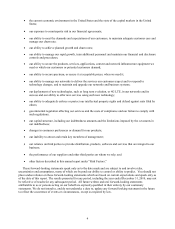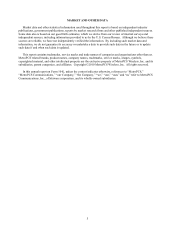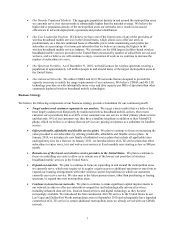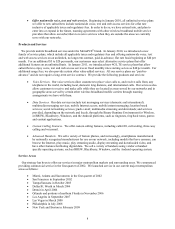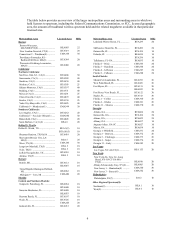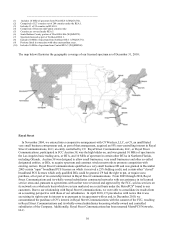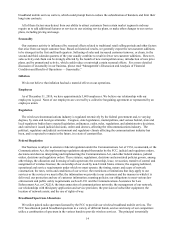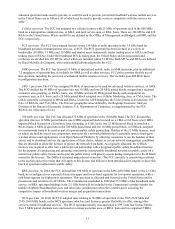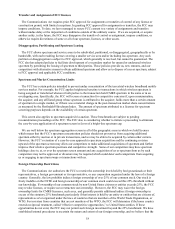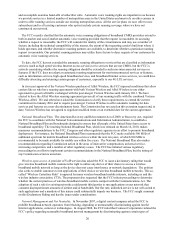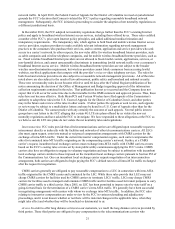Metro PCS 2010 Annual Report Download - page 22
Download and view the complete annual report
Please find page 22 of the 2010 Metro PCS annual report below. You can navigate through the pages in the report by either clicking on the pages listed below, or by using the keyword search tool below to find specific information within the annual report.
12
LTE, in a cost effective manner, and increased privacy and security. We believe 4G LTE offers several key
advantages over third generation and other fourth generation air interface protocols, including higher network
capacity, potential worldwide market for devices and equipment, and an efficient upgrade path to voice over Internet
Protocol, or VoIP, and other advanced services. CDMA and 4G LTE are incompatible with certain other air
interface protocols. Customers and former customers of other carriers may not be able to use their wireless devices
on our networks because either their wireless device uses a different air interface protocol, may have deployed air
interface protocols on different frequency bands, or the other carriers with compatible air interface protocols may
have restricted the customers from changing the programming of their wireless device to allow it to be used on
networks other than the original carrier’s network.
Competition
The retail market for broadband wireless services is highly competitive. We compete directly in each of our
metropolitan areas with other facilities and non-facilities based wireless broadband mobile and fixed service
providers, wireline, Internet, cable, satellite and other communications service providers by providing a wireless
alternative to traditional wireline service. We believe that competition for subscribers among wireless broadband
mobile providers is based mostly on price, service area, services and features, handset selection, call quality and
customer service.
The current facilities-based wireless broadband mobile industry is dominated by four national carriers -- AT&T,
Verizon Wireless, Sprint Nextel and T-Mobile -- and their prepaid affiliates or brands. These national carriers
typically offer post-paid plans that subsidize wireless devices, but require long-term service contracts and credit
checks or deposits. Many of our competitors offer service plans with large bundles of minutes of use at low per
minute prices or price plans with unlimited nights and weekends and some of our competitors offer unlimited
service plans similar to ours. Our competitors’ plans could adversely affect our ability to maintain our pricing,
market penetration, growth and customer retention. These national carriers also have introduced, either directly or
through their affiliates, increasingly competitive unlimited fixed-rate services plans in areas in which we offer
service. These unlimited fixed-rate service plans may cause other competitors to introduce similar or increasingly
competitive unlimited fixed-rate plans. Following declines in the adoption of post-paid plans, some national carriers
have become increasingly aggressive in offering and marketing prepaid and pay-in-advance services on a no long-
term contract basis and, in some cases, have relaxed their requirements for long term contracts or credit checks. In
addition, other facilities-based regional wireless broadband mobile carriers, such as Cricket Communications, an
affiliate of Leap Wireless International, or Leap, have unlimited fixed-rate service plans similar to ours and compete
in certain of our markets.
In addition to facilities-based wireless broadband mobile carriers, the wireless broadband mobile industry also
includes carriers such as Tracfone and PagePlus that are non-facility based mobile virtual network operators, or
MVNOs, that contract with wireless network operators to provide a separately branded wireless service. In some
cases these MVNOs have business arrangements with one of the other major nationwide carriers, which may give
them access to a more extensive network than ours. These MVNOs offer increasingly competitive service plans
similar to the service plans we provide in addition to offering more traditional prepaid plans that charge by the
minute.
The wireless broadband industry also includes other new entrant facilities-based providers, such as Clearwire and
Lightsquared. Clearwire is building a network utilizing WiMax, which is the name given to a family of digital
technologies that are capable of supporting high-speed, long-range wireless services suitable for mobility
applications, using spectrum predominately in the 2.5 GHz range to construct a national network to provide wireless
data and telecommunications services. Clearwire owners include Google, Intel, Sprint, Comcast, and Time Warner
Cable. Lightsquared holds satellite spectrum covering North America which also permits it to build ancillary
terrestrial facilities to supplement its satellite based services. Lightsquared has announced that it plans to build a
new nationwide 4G LTE wireless broadband network integrated with satellite coverage in the United States and will
provide wireless broadband capacity to a diverse group of customers, including retailers, wireline and wireless
communication service providers, cable operators, device manufacturers, web players, content providers, and many
others. The Lightsquared network will allow these customers to offer satellite-only, terrestrial-only, or integrated
satellite-terrestrial services to their end users.
The wireline voice and broadband industry is dominated by large incumbent carriers, such as AT&T and Verizon.
In addition, large cable companies, competitive local exchange carriers and VoIP service providers also provide
competition for wireline voice and broadband services. The cable industry is dominated by large carriers such as




